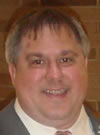In The Beginning
During the time frame of 1975-1979 John passed the 14 professional exams to become both a Fellow of the Society of Actuaries and a Certified Public Accountant. However, it was not these exams that defined him as a professional but at least three practical experiences around the same time.
In 1978 John was asked to take the lead in auditing the five pension systems of one of the largest cities in the world. The software for this system was written by one of the largest insurance companies in the world. He was equipped with a new TI 59 calculator he had just purchased. The only option for checking the numbers was to look at ratios of one actuarial value to another to see if they made sense. In addition, it had been in the news that one of the systems gave higher benefits (60% higher) if someone retired disabled and that many participants in the plan were taking advantage of this feature. John soon realized that the liability numbers did not seem to reflect the expected increase amounts.
After further investigation with the chief actuary for the system, they realized that the insurance company assumed a 25 times higher incidence of liability before retirement but no extra disability after the participant reached retirement. The extra liability was about $250 million, not a small amount in 1978, and an extra $30 million was put each year to amortize this shortfall.
On another of this city’s pension systems, John discovered a $24 million error, also, based on “poor thinking”.
About that same time, as inflation was picking up in the late 1970’s John’s boss got a call from an actuary, with another firm, who was working on one of the three very big companies in a major industry about raising the interest rate assumption. The three actuaries from the three companies wanted to raise interest rates together. It was part an exchange of thoughts (a good thing), but it seemed there was, also, a fear of being the first to make the change.
About two years later John represented another firm at a hearing with the Financial Accounting Standards Board (FASB) on developing guidelines for accounting of pension plans. In the hearing he was asked by the head of the FASB to write a paper on how the interplay of plan design and funding strategy should inform pension accounting guidelines. The paper John wrote was a key part of the financial standards that were developed.
Over his 45-year career, John has had similar experiences on dealing with a solution to the Social Security funding problems, developing a spreadsheet to handle Statement of Financial Accounting Standards #87 (on Pension Accounting), integrity in handling Combo Plan design, etc.
Garnered from these and other experiences, John’s experience has shown him:
Unfortunately, many in our profession seem more interested in fitting in with the group than focusing on what is best for the customer.
That compliance (which is, of course, necessary) is not consulting. That “staying out of trouble” is not the same as optimizing a plan (design and funding).
Many things can be done to help a client without “pushing the envelope” by interpreting laws and regulations in a way that was never intended by Congress or regulators.
That the key for success is in developing good relationships with our clients and knowing how their business is currently progressing. Accomplishing this goal allows us to regularly assess plan design and adjust funding strategies in order to optimize the benefits the plan provides.
Team Bio:
John S. Agatston, PresidentEA, MSPA John graduated from Carnegie-Mellon University in 1972 and in 1977 completed the Exams to become a Certified Public Accountant in New York City while working for Peat, Marwick, Mitchell & Co. John then became an Associate in 1977 taking the exam the day after the last CPA exam. 1978 saw John leading an Actuarial Audit of New York City's five retirement systems. As part of the audit John found a $250 million error in the Firemen’s pension fund for which the City had to contribute an extra $30 million a year for many years to make up. In 1979 John became a Fellow of the Society of Actuaries and in 1980 became an Enrolled Actuary under ERISA at which time he became Chief Actuary for Johnson and Higgins in Pittsburgh. John began moving onwards and upwards in the 1980's. In 1981 John testified at the hearing on pension expense before the Financial Accounting Standards Board (FASB). At the request of the FASB Chairman he wrote a paper entitled "The Effect of Plan Design and Actuarial Methods and Assumptions on Pension Costs and Liabilities". Several concepts from this paper were incorporated into the Statement of Financial Accounting Standards No. 87 (SFAS 87). Later on in 1987 John developed a two dimensional worksheet for doing the SFAS 87 Report for use in his own practice at John S. Agatston Actuarial Services (which he started in 1983) which was gradually used in different forms around the country. 1982 saw John participating in a committee of three actuaries that set up a range of acceptable assumptions under the new act 205 for Municipal Pension Plans in Pennsylvania. During the 1980's John was President of the Actuarial Club of Pittsburgh and in 1987 John worked on a paper dealing with the coming funding crisis in Social Security. In 1993 John completed the exams to become a Chartered Financial Analyst and in 2006 John wrote a key article for the ASPPA Journal, “The Dawn of a New Era – Opportunities and Responsibilities for Pension Professionals”, on the newly passed Pension Protection Act of 2006. Along with Greg, John has been developing and coding the company’s valuation software as well as pursuing constant improvement in his firm's quality and output. |
Greg Elynczky, Chief ActuaryEA, MSPA, COPA, CPC, QPA, QKA Greg graduated from Carnegie Mellon University in 1990 and began working for John S. Agatson Actuarial Services in 1994. In 2005 Greg became an Enrolled Actuary under ERISA and a Member of the American Society of Pension Professionals and Actuaries. In 2007 Greg became a Qualified 401(k) Administrator, Qualified Pension Administrator and Certified Pension Consultant of the American Society of Pension Professionals and Actuaries. In 2009 Greg was accorded as Fellow of the American Society of Pension Professionals and Actuaries. He is the technical legal expert for our firm and many other actuaries and attorneys seek his technical expertise. Greg has served on the Document Sub-committee of the Government Affairs for ASPPA with the heads of most of the major pension document software companies since 2006. Usually this has meant he has been the only actuary on the monthly conference call with these lead pension attorneys. Greg also served as Vice President of Programs for the Western Pennsylvania ABC Council of ASPPA from 2006 to 2012. Greg has been responsible for designing and coding the firm’s defined benefit valuation system with John since 1996. He also designs and consults on pension plans. |
|
Arik Miller, Operations/IT ManagerArik Miller is our Operations Manager. Arik is reponsible for the overall sucess of our firms internal operation and our client relationship initiative. Arik produces the 5500's for distribution to our clients and submitting them to the IRS/DOL. Arik handles the PBGC Termination process and oversees the software development process. Arik is currently working towards his Defined Contribution Certifications. Arik is former military and a graduate from the United States Navy Leadership, Management Educational Training facility located in Whidbey Island, Washington. Arik has held certifications as an ISO 9000 Lead Assesor, AQS Certified Quality Auditor, AWS CWI/CWE, ASME Section 8 Div 1 Inspection and various other professional certifications for time management and human resources. His IT background includes computer programming and software development, Hardware Systems Design and Construction, Systems Integration, Quality Systems Development and Implementation, Dbase generation and implementation, Website design and operational systems development. Arik an avid hunter and fisherman, competitive long range shooter and is a licensed gunsmith. |
Avivah Miller, Office ManagerAvivah has many years of experience managing office systems. Avivah is instrumental in the preparation and production of plan documents for our clients. Avivah heads up our data collection activity and assits in the data reconciliation process as well as 5558 generation and submittal. Avivah also produces actuarial valuations/reports and PBGC filings for our clients. Avivah operates our Accounts Receivables Department and is a major player in our client relationship initiative. |



















